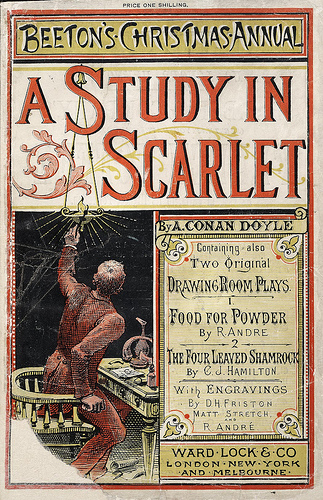
“The Adventure of the Musgrave Ritual” is one of Sherlock Holmes’s earliest cases. Before Holmes met Watson, he was friends with Reginald Musgrave, whom he met in college. Musgrave seeks Holmes’s help after his butler and maid vanish mysteriously. Musgrave recounts that he happened upon his butler examining a map and an old family document called the Musgrave Ritual, which each generation of Musgraves recites upon accession of the family title and property. Musgrave doesn’t think it means anything, but Holmes is not so sure, and he deduces that it is a riddle that together with the map will lead Musgrave and Holmes to discover what happened to the butler and maid.
One of the most enjoyable aspects of “The Musgrave Ritual” was its description (possibly introduction) of some of Holmes’s quirks: his “untidy” nature, his habit of fixing unanswered correspondence to the mantel with a jack-knife, his abstracted fiddling with his violin, and his shooting his gun at the wall. As a story itself, it’s a nice little mystery, if not without its flaws—in order for the secret riddle to work, trees would need to remain the same height over hundreds of years, and the time of year (which would be important in calculations) isn’t accounted for, not to mention paces as means of measurement are fairly unreliable as people will have vastly different strides. I love it that Reginald Musgrave just happened to get a wild hair and measured the height of all the trees on the property using trigonometry. We all did that in our crazy schooldays, didn’t we? Still, it’s a fun mystery, and it winds up being a genuine treasure hunt, too, with a connection to the Royal Family. “The Musgrave Ritual” was originally published in The Strand in 1893 and was later collected in The Memoirs of Sherlock Holmes.
Update 1/16/17: Season 4, episode 3 of Sherlock was just broadcast last night, and now that the debriefs with spoilers are online, I feel I can update this post to add some of the references to “The Musgrave Ritual” that I noticed in “The Final Problem.” First, Sherlock’s home was called Musgrave, and the rhyme Eurus gives as a clue to the whereabouts of Sherlock’s friend are not too different from the rhyme in “The Musgrave Ritual.” The home is not terribly different from the Musgraves’ home, and the ultimate solution leads Sherlock to discover a grisly death not too different from that of the butler in the short story. Please also check out my post updating “The Gloria Scott” review with Sherlock references to that story.
The episode “The Abominable Bride” in the new Sherlock series references “The Musgrave Ritual”—Sherlock mentions several cases in this story, one of which is a “full account of Ricoletti of the club-foot and his abominable wife.” A tiny reference like that is proof that Gatiss and Moffat are true fans of the stories. I have to admit, I don’t wonder they wanted to play with the potential of the story. Who doesn’t want to know more about Ricoletti of the club-foot and his abominable wife? That particular episode of Sherlock was a Christmas special, and it’s unique in that it’s the only episode set in the Victorian era. It was a really fun episode. I loved the costumes. You can check out the trailer here:
Rating:




 I read this story as part of the Chronological Sherlock Holmes Challenge. It is the second short story in the chronology (time setting rather than composition). Next up is The Study in Scarlet, which I have already read, so look for more Sherlock Holmes next month.
I read this story as part of the Chronological Sherlock Holmes Challenge. It is the second short story in the chronology (time setting rather than composition). Next up is The Study in Scarlet, which I have already read, so look for more Sherlock Holmes next month.







 About Cathi Hanauer
About Cathi Hanauer








